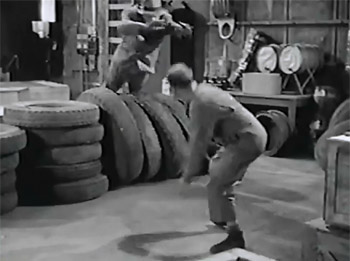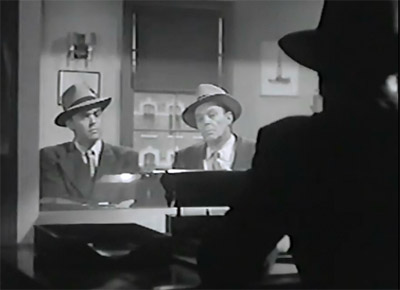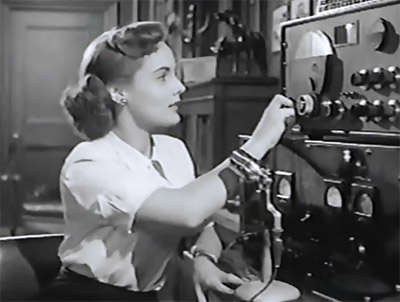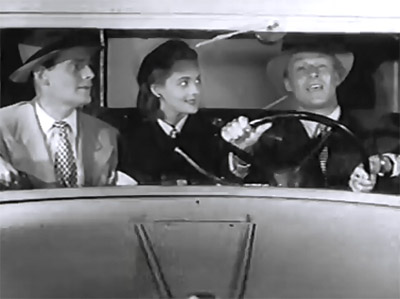
Republic, 12 Chapters, 1951. Starring Walter Reed, Mary Ellen Kay, Dick Curtis, John Pickard, Fred Coby, Pierce Lyden, Mauritz Hugo, George Meeker, Arthur Space.
A ruthless gang of hijackers is capturing trucks full of uranium, radar equipment, and other valuable materials that can be sold for big profits to foreign agents; the concerned government assigns trucking-company owner and former wartime Intelligence operative Hal Duncan (Walter Reed) to defeat the threat. With the cooperation of the other shippers in the Interstate Trucking Association (George Meeker, Arthur Space, Pierce Lyden, Mauritz Hugo), and the more active help of his partner Sam Bradley (John Pickard) and Association secretary Kay Roberts (Mary Ellen Kay), Hal blocks one hijacking scheme after another and tangles repeatedly with lead hijackers Regan and Cady (Dick Curtis and Fred Coby), while becoming increasingly certain that one of the four Association members is the secret boss of the highway bandits.
Government Agents vs. Phantom Legion has often been denounced by critics as one of Republic’s dullest chapterplays, lacking as it does the science-fiction trappings that have given other late-fifties Republics like Radar Men from the Moon a mild fan following among latter-day viewers. While it’s true that the serial’s silly title promises a more colorful set of villains than it delivers (a “Phantom Legion” really should consist of something more than thugs in suits), the serial itself is far from dull, despite its mundane subject matter. Like most other Republics of the period, it’s a skillful combination of impressive old footage with respectable new footage, made entertaining by its swift pacing and its likable cast.
Ronald Davidson’s script for Government Agents follows standard Republic formula, with the villains’ successive hijacking attempts and the hero’s counter-measures providing the impetus for the action, their ongoing duel occasionally punctuated by direct attempts on the hero’s life or the hero’s efforts to discover the traitor among the Association members. As in other late Republics, the serial’s streamlined running time minimizes the negative effects of this repetitious plotting; Government Agents’ chapters zip by so fast that the circular storyline never becomes tedious. The serial’s abridged format, however, keeps Davidson from doing full justice to his mystery-villain subplot; there’s no time here for red-herring antics on the part of the Association board members, who spend almost all their screen time merely sitting round a table and applauding or criticizing the hero’s plans.

Above: Walter Reed (at head of table) makes a report to the red-herring board. Mary Ellen Kay is behind Reed; the suspects, left to right, are George Meeker, Arthur Space, Mauritz Hugo, and Pierce Lyden.
Davidson, as always, does an expert job incorporating Republic’s stock footage into his script, the novel trucking-centered storyline allowing for the use of some unfamiliar and interesting pieces of truck action from Republic’s earlier feature films, as well as for more recognizable bits from the studio’s serials. The pursuit of the hero’s truck along a desert road in the first chapter, and the fight between Walter Reed and Dick Curtis atop a speeding truck in the second episode, are the most striking of the serial’s tractor-trailer sequences–both of them so well-edited that only my knowledge of Republic’s low 1950s budgets makes me sure that they’re built around stock shots.

Other action scenes–chiefly the chapter endings–are blended just as skillfully into the serial, but are easier for a chapterplay buff to spot; among them are the handcar chase in the burning tunnel from Spy Smasher, the flaming-highway cliffhanger from Mysterious Doctor Satan, the remote-control truck sequence from Captain America, and the boat collision from Dick Tracy vs. Crime Inc. The few brand-new cliffhanger scenes, like Walter Reed’s seeming impalement on a pick-head (Chapter Five) and his fall from a window (Chapter Eleven) are of necessity unspectacular in concept but are well-staged, with the former scene being neatly set up with a zoom shot of the deadly implement and the latter being strikingly foreshadowed by a downward shot of the pavement as Reed battles above it.


Above: The Chapter Eleven cliffhanger.
Except for the truck scenes and some car-chase shots, the serial’s mid-chapter action consists of new footage, which is handled quite neatly by director Fred C. Brannon and stuntmen Dale Van Sickel and Tom Steele (who double hero Walter Reed and action heavy Dick Curtis, respectively). The fight in the warehouse in Chapter One is a standout, making effective use of tires, oil drums, crates, and other props; the dockyard fight in Chapter Eight is also good, with Van Sickel, Steele, Eddie Parker, and Duke Taylor (doubling Fred Coby) energetically flipping and kicking each other as they battle up and down a set of wooden stairs. Carey Loftin (a specialist in stunt driving) and Dick Crockett also contribute to the serial’s action.


Above left: Dale Van Sickel leaps at Dick Crockett in the Chapter One fight scene. Above right: Duke Taylor takes a kick from Van Sickel in the Chapter Eight dockyard fight.
Other action highlights include the Chapter Three train-station fight, the Chapter Four office brawl (during which Van Sickel–doubling John Pickard this time–does a neat slide down a table), the suspenseful Chapter Six fight that has the combatants narrowly and repeatedly missing a container of deadly gas bulbs, the Chapter Eleven fight in the villains’ hideout, the last-chapter climactic fight in a burning room, and the refreshingly unusual Chapter Nine sequence in which the captive hero–driving the villains’ car–begins to speed recklessly and grimly threatens to kill himself and the heavies, forcing them into surrender. This scene, like the serial’s several car chases, foot chases, and shootouts, is filmed out on the hilly roads at Iverson’s, visually balancing out the offices, warehouses, and similar indoor sets that provide a backdrop for other action scenes.

Above: The heavies leave their car to chase the (off-camera) hero across country at Iverson’s.
The serial’s leading cast members handle their parts with conviction, most of them giving at least a modicum of personality to their underwritten characters. Walter Reed makes a good hero, his toughly authoritative line delivery and doggedly determined manner balanced by a touch of wry cheerfulness and some unexpected but convincing displays of alarm in dangerous situations. John Pickard, who would go on to a good career as a character player and–briefly–a star in film and TV Westerns, is far more interesting in his sidekick role than most Republic second leads; his tough appearance, distinctive Tennessee twang, and likably jovial handling of occasional quips combine to give him a screen presence of sorts.

Above: Walter Reed and John Pickard.
Mary Ellen Kay, the diminutive but lovely heroine of many of Republic’s later B-westerns, is quite noticeable as well, her good looks appealingly set off by an assortment of outfits (this varied wardrobe practically constitutes a “glamor treatment” by late Republic standards). Although her appearances are limited almost entirely to expository office scenes, her looks and her pleasant personality help to brighten up each chapter; her character is also drawn into the action on occasion, giving her a few opportunities to display the feisty energy seen in her Westerns.
Veteran heavy Dick Curtis serves, to all intents and purposes, as the serial’s main villain–snarling nastily, scheming craftily, and aggressively and convincingly threatening the good guys with his towering frame; his energetic performance and menacing presence render the serial’s lack of a more bizarre villain quite moot. Curtis’s assistant action heavy Fred Coby, though properly swarthy and sinister in appearance, is decidedly bland in comparison; he handles his role competently but is easily the least interesting of the serial’s major players.

Above: Fred Coby (far left) and Dick Curtis receive orders from their shadowy boss.
The serial’s quartet of suspects (composed of some excellent B-western and serial heavies) make the most of their limited screen time; George Meeker is icily calm, Mauritz Hugo harshly cranky, Arthur Space suavely congenial, and Pierce Lyden gruffly straightforward–all of them projecting enough menace to be conceivable mystery-villain candidates. The mystery villain himself, dubbed “the Voice” in the serial’s publicity material but unnamed in the serial itself, is merely a shadowy man in a suit but is lent a little visual interest by his plotting sessions with his henchmen from behind a two-way mirror. The guilty suspect, incidentally, provides the voice of “the Voice” in these scenes.
Edmund Cobb and Eddie Dew have prominent billing but miniscule henchman parts, while Eddie Parker and Dale Van Sickel have far more lines in their incidental henchman roles; Tom Steele, Duke Taylor, and Dick Crockett also pop up as thugs. Frank Alten appears as a crooked janitor, George Lloyd as a coroner, Ralph Dunn as a policeman, and Norval Mitchell as the District Attorney. John Phillips is as dull as dishwater as the solemn government agent who gives Walter Reed his assignment, and prominent Columbia serial heavy Terry Frost has a small role as a henchman in the first chapter (I myself would have preferred to see Frost in Fred Coby’s role). Roy Barcroft, practically ubiquitous in Republic’s later productions, turns in a quick voiceover performance as a Coast Guard dispatcher in one episode.
Government Agents vs. Phantom Legion should probably have been given a less grandiose title that would have better matched its storyline–something like Highway Raiders or G-Men vs. Hijackers Inc.–but in all other departments it’s a competent and enjoyable serial, if a predictable and formulaic one. Its heroes, heroine, and principal villain are enjoyable to watch in action, and its automotive and fistic action scenes are consistently brisk and exciting; the end result is very unmemorable, but very watchable.


being the serial fanatic,I applaud this late entry for its use of stock footage. Im not overly zealous about Republics late entries. Entertaining yes,but for me the zip had long since been gone. Rating 2 stars out of five.
“Government Agents vs Lydecker Stock Footage” is more like it, but as latter-day Republics go, this one is certainly fast paced and actually quite enjoyable. Walter Reed and John Pickard make a good team, and Dick Curtis has a nice turn as the primary action heavy. The mystery villain angle is pretty much wasted, but at least the group of suspects had some variety, if not much to do otherwise. Mary Ellen Kay is definitely attractive and nicely costumed, but for me, her line readings are more at the level of high school dramatics and not very effective.
I wish that I knew more about the cars of the late 1930’s – early 1950’s era, if only to be able to identify all the vehicle switches made by the heroes and villains that were necessitated by the use of the stock footage. And, as always, it was great to see the “woodie” wagon in action. As a former Southern California 1960’s beach goer, that was one ride that we all wanted to own.